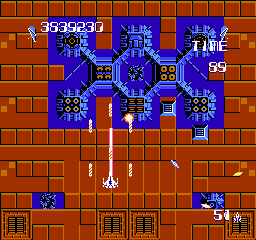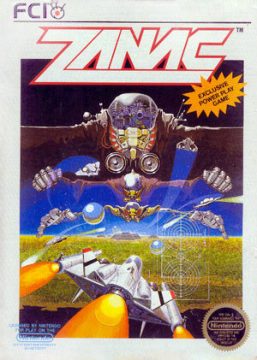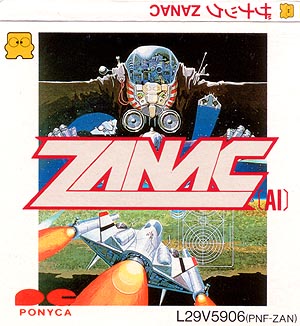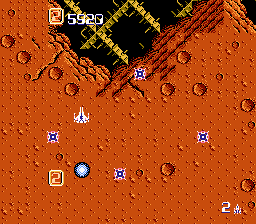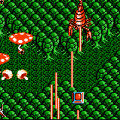- Zanac
- Zanac x Zanac
Compile was one of the most prolific shoot-em-up developers of the late ‘80s and early ‘90s. Starting out as a small developer named Programmers-3, they heavily supported the MSX home computer, and later worked on most other consoles, with a variety of publishers. Zanac, published in 1985, is not the first shoot-em-up developed by Compile – that honor would go to 1983’s Devil’s Heaven – but it is the game that set down the template for nearly all of their future shooters. The game was first published on the MSX, with revised ports being released for the Famicom Disk System (in Japan) and NES cartridge (in America), along with an enhanced version called Zanac EX for the MSX2. All were published by Pony Canyon.
There are three core members of the Compile shoot-em-up team, starting with Zanac. Masamitsu “Moo” Niitani is a designer, and also company president; later games have him more in a producer role. Kouji “Janus” Teramoto is primarily a graphic artist, and Takayuki “Jemini” Hirono is the main programmer. The music for Zanac (and many other Compile titles through the end of the ‘80s) was by Masatomo Miyamoto.
The story involves a device, created by a long lost alien race, called the “System”. After humanity tries (and fails) to harness its power, it goes rogue and attacks Earth, leaving them to strike back with the Zanac starfighter, which is small enough to weave through its large scale defenses. The name “Zanac” is an anagram for “Nazca”. The mountains-and-plains setting is practically identical to Namco’s Xevious, released two years before, which featured the mystical Nazca lines. Zanac doesn’t have these but the similar setting is apparent. This connection only applies to the MSX release though, as the later versions changed the visuals substantially.
The main draw of Zanac is the “artificial intelligence” that determines the types of enemies that the game throws at you. These include, primarily, the power of your weapon and the type of weapon you have equipped, along with the how fast you hammer the fire button. In the original MSX version, there’s an indicator that reads “ALC” (“Automatic Level Control”), a hexadecimal number that indicates the AI behavior. (Of course, there’s no context for what any of the letters or numbers actually means, so it’s just there to look cool.) This is one of the earliest concepts of “rank”, that is, the game altering the difficulty level on the fly depending on player performance.
There are two types of weapons in Zanac. Your main gun is a single shot bullet, but can be powered up to several levels. Throughout each level, there are many formations of three boxes next to each other. Typically, one is empty, one fires out bullets, and one has an orb that will upgrade your main weapon. (This pattern changes depending on the rank.) Grabbing any power-up will also make you temporarily invulnerable, which adds an extra strategic element.
You’re also equipped with a secondary weapon, which are determined by numbers 0 through 7. By default, you always have a 0 weapon, which is an “all-way” attack that can be aimed in eight directions. Other weapons are also found, either in boxes on the game’s landscape, or from flying power-up carriers. The latter often cycle through different numbers, letting you pick what you want to equip yourself with. Weapons can be powered up and replenished by grabbing more power-ups of the same number.
The large arsenal is a hallmark of Compile games. Some are offensive, some are defensive, meant to work in tandem with the main gun. The all-way weapon is relatively powerful considering it’s a default weapon. Weapon 2 is a shield, while weapon 3 fires several balls of energy in a circle around your shield. Weapon 6 is essentially a smart bomb, killing almost everything on the screen. Each of these subweapons (outside of 0) is limited, either in time or usage, though it can be replenished by picking up more icons. Getting killed will also reset both your main and sub weapons.
The scrolling is extremely fast, and there’s rarely a moment where the game slows down. When it does (and this is part of the pre-determined level design, rather than part of the AI), it’s to fight a midboss. Many of these are ground bases, formed of many glowing turrets, which open and close to flood the screen with fire. This type of enemy became a hallmark of many early Compile shooters. There’s a time limit to destroy these, however. The game is generous enough to spawn weapon power-ups during battle, so you can still get new weapons even if you run out or die.
If there’s any downside to Zanac, it’s that there’s not much variation in the levels, outside of slightly different bosses. It’s also a long game – a full play takes nearly an hour. (The long playtimes are also a trademark of Compile shooters.) It’s also incredibly hard – the AI isn’t exactly balanced and can toss nearly impossible patterns at you, so there are obscure strategies to undertake to manipulate it. To allay this, it’s very generous when handing out extra lives, both as item drops and as score bonuses.
This is the biggest issue with the original MSX release. There’s almost no variation in terrain over the first seven levels, just assorted green plains and blue oceans. It’s not until the eighth and final level where it changes to represent the enemy’s final base.
The biggest change to the FDS/NES version is that it alters the levels – there are 12 instead of 8, and each has its own original design, so at least it feels a little less repetitive. The MSX2 version uses different colors and terrain, but otherwise is based on the NES/FDS level structure. The MSX version also has typical jerky scrolling (though not as bad as other shooters like the ones from Konami) while all of the later releases are much smoother. The FDS/NES/MSX2 versions also change some of the weapons, plus it removes the sidebar and puts the data on other part of the screen, making for a larger view. Between the FDS and NES versions, there are some minor changes in enemy behavior, but are basically the same. All screens on these pages (other than the comparisons) are from the NES version.
There are a number of hidden tricks in Zanac, like ways to immediately power-up your guns, reset the AI, or warp through levels. There are also bonuses that take the form of either Randar, the blue (or red) smiley face alien who acts as Compile’s mascot, or as a fairy named Rio.
While all of Compile’s games improved and refined the formula set down by Zanac, it’s still an intense shooter with plenty of depth, and a catchy (if repetitive) soundtrack. It’s also fascinating to see the primordial roots of the vertical shoot-em-up genre.
Both the FDS and NES cart versions of Zanac are included in Zanac X Zanac for the PS1, along with a “Special” mode that makes further changes.
Screenshot Comparisons

